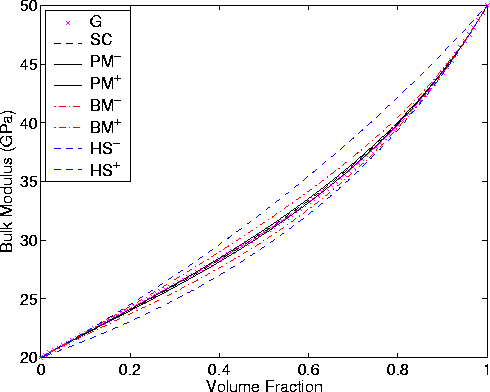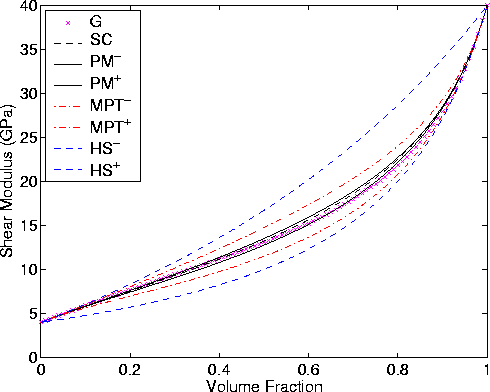 |
Figure 2 Comparison of (a) the (uncorrelated) bounds of Hashin and Shtrikman (HS
 |
 |
Figures 2 and 3 provide some examples of elastic constant bounds
and estimates for a system having two constituents with
K1 = 20, K2 = 50, ![]() ,
, ![]() , all constants
measured in GPa.
, all constants
measured in GPa.
The Hashin-Shtrikman (uncorrelated) bounds (HS![]() ) are the outer
most bounds for both bulk and shear modulus. The Beran-Molyneux
(BM
) are the outer
most bounds for both bulk and shear modulus. The Beran-Molyneux
(BM![]() ) bounds for bulk modulus and the Milton-Phan-Thien
(MPT
) bounds for bulk modulus and the Milton-Phan-Thien
(MPT![]() ) bounds for shear modulus -- in both cases the shapes of
the inclusions are assumed to be disk-like -- are the next bounds as
we move inward. Then the Peselnick-Meister (PM
) bounds for shear modulus -- in both cases the shapes of
the inclusions are assumed to be disk-like -- are the next bounds as
we move inward. Then the Peselnick-Meister (PM![]() ) bounds
for polycrystals of hexagonal grains are applied to grains laminated
so that their volume fractions of type-1 and type-2 are always the
same as that of the overall composite being considered here. These
PM
) bounds
for polycrystals of hexagonal grains are applied to grains laminated
so that their volume fractions of type-1 and type-2 are always the
same as that of the overall composite being considered here. These
PM![]() bounds lie strictly inside the BM
bounds lie strictly inside the BM![]() and MPT
and MPT![]() bounds.
Then the inner most curve is the SC curve generated as described here
by using the analytical forms of the PM
bounds.
Then the inner most curve is the SC curve generated as described here
by using the analytical forms of the PM![]() bounds to construct
self-consistent estimates for the random polycrystal of laminates
model. This SC curve is always inside the PM
bounds to construct
self-consistent estimates for the random polycrystal of laminates
model. This SC curve is always inside the PM![]() bounds and therefore
inside all the bounds considered here. Finally, we have the geometric
mean estimates G, based on the improved bounds of BM
bounds and therefore
inside all the bounds considered here. Finally, we have the geometric
mean estimates G, based on the improved bounds of BM![]() and MPT
and MPT![]() .These estimates always lie between these two bounds, but not always inside the
PM
.These estimates always lie between these two bounds, but not always inside the
PM![]() bounds. This result shows that the BM and MPT bounds are
allowing for a wider range of microstructures than are the PM bounds,
which is entirely reasonable under the circumstances. The main
practical observation however is that the PM
bounds. This result shows that the BM and MPT bounds are
allowing for a wider range of microstructures than are the PM bounds,
which is entirely reasonable under the circumstances. The main
practical observation however is that the PM![]() , SC, and G curves (both
bounds and estimates) are in fact all very close to each other
(differing by less than 2% maximum for this high contrast example).
This fact suggests that any or all of these curves could be used when
designing new composites having preassigned elastic properties, or for
analysis of seismic wave data for interpretation purposes. The
errors in these predictions would likely be close to the experimental
errors in the construction of such composites and therefore negligible
for many, though perhaps not all, practical purposes.
, SC, and G curves (both
bounds and estimates) are in fact all very close to each other
(differing by less than 2% maximum for this high contrast example).
This fact suggests that any or all of these curves could be used when
designing new composites having preassigned elastic properties, or for
analysis of seismic wave data for interpretation purposes. The
errors in these predictions would likely be close to the experimental
errors in the construction of such composites and therefore negligible
for many, though perhaps not all, practical purposes.